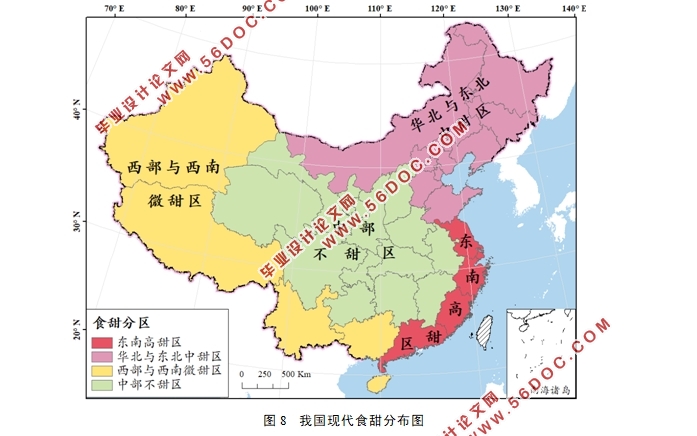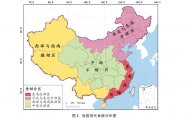基于网络大数据的现代食甜习惯空间分布特征研究(论文18000字)
摘要:饮食地理文化作为地域文化中最具地方特色的重要元素,在现代人口大规模流动背景下呈现新的多样化局面,而基于传统认知的我国食甜分布特征始终缺乏客观数据支持。本文采用网络爬虫技术,获取我国大陆31个省会城市共计约2000万条美食消费数据,从传统类菜品、主食类菜品、饮料类和甜品类菜品四个方面计算城市食甜度,在ArcGIS、MySQL软件支持下,借助GIS空间分析和数理统计方法探究我国现代食甜习惯空间分布特征,分析影响食甜分布的因素。研究结果表明:① 我国食甜在空间分布上存在显著的地域分异特征,突出表现在东南沿海食甜度高,中部内陆地区食甜度低,总体呈现“东高北中西微内低”的包围式格局;② 从整体抑或局部角度,我国食甜均呈现显著的空间正相关关系,不存在明显的分散趋势,(不)偏爱食甜区域在空间上集聚,形成特色鲜明的3个地理集聚区,即以苏浙沪闽为主的东南沿海高甜集聚区,以渝黔川为主的西南内陆和以陕宁为主的西北内陆低甜集聚区;从集聚程度上看,我国食甜在局部存在不同聚类水平的冷热点区域,热点区域集中在苏浙沪闽粤的东南沿海一带,冷点区域集中在西北西南地区,集聚状态均属于中高度水平;③ 日照、湖泊面积及地理位置是形成现代我国食甜空间分布的重要因素,且地理位置对日照影响食甜的过程产生调节作用,具体表现为:内陆地区城市食甜度一般随着日照时长的增长而增大,沿海地区城市食甜度往往随着日照时长的缩短而减小。该研究旨在揭示现代社会变更下我国甜食文化特征,以期对城市餐饮行业门类结构的分布与规划提供参考价值,继而进一步把握现代食甜消费发展的新趋势。
关键词:城市食甜度;大数据;空间自相关分析;逐步回归分析
The Spatial Distribution Analysis of the Modern Sweet Diet Based on Big Data of Network
Abstract: As the most important element with local characteristics in regional culture, dietary geographic culture presents a new diversified situation under the background of a large-scale population flow. However, up to now, the domestic research on the distribution characteristics of sweetness of food based on traditional cognition is still lack of objective data. Based on the web crawler technology, this paper obtained about 20 million pieces of gourmet consumption data in 31 provincial capitals of mainland China. The degree of sweetness of food in urban areas was calculated by traditional dishes, staple food dishes, drinks and dessert dishes. Taking spatial analysis and mathematical statistics as the method, with the support of ArcGIS and MySQL software, the spatial distribution characteristics of the Modern Chinese Sweet Diet were explored and the factors affecting the distribution characteristics were analyzed. Results showed that: (1) There are significant regional differences in the spatial distribution of sweet food in China, especially in the southeastern coastal areas and the central inland areas. It generally presents a surrounding pattern of “High East, Middle North, Micro-low West and Low Inside”. (2) No matter from the overall or local point of view, there is a significant positive spatial correlation between Chinese sweet foods, and there is no obvious trend of dispersion. Preference(or not) for sweetness of food gathers in space, forming three distinct geographical agglomeration areas, that is, the high-sweetness agglomeration areas along the southeast coast of Jiangsu, Zhejiang, Shanghai and Fujian, the southwest areas of Chongqing, Guizhou and Sichuan, and the northwest inland low-sweetness agglomeration areas of Shaanxi and Ningxia. Also, with the improvement of traffic accessibility, the trend of spatial agglomeration in sweetness of food in urban areas will be further strengthened in the future. In terms of agglomeration degree, there are different levels of cold hot spot clustering regions in the local space of sweet food in China. On one hand, the hot spots are concentrated in the southeast coastal areas of Jiangsu, Zhejiang, Shanghai, Fujian and Guangdong, with the agglomeration state belonging to medium-high level, and on the other hand , the cold spots are concentrated in the northwest and southwest regions, with the agglomeration state belonging to the medium-high level; (3) Sunshine, Lake area and Geographical location are important factors to influence the spatial distribution of sweet food in modern China, and more importantly, geographical location has a regulating effect on the process of sunshine affecting sweet food. Specifically, the sweetness of inland cities generally increases with the increase of sunshine duration, while the sweetness of coastal cities usually decreases with the decrease of sunshine duration. This study aims to reveal the regional disparity of sweet culture in modern China, so as to provide reference for the planning of the category structure in urban catering industry, and then further grasp the new trend of the development of modern sweet food consumption.
Key words: Sweetness of food in urban; Big data; Spatial autocorrelation analysis; Stepwise regression analysis

目 录
1 研究背景与意义 1
2 国内外研究进展 1
2.1 国内研究现状 1
2.1.1 食甜相关的研究进展 2
2.1.2 餐饮行业中大数据的获取与处理研究 2
2.1.3 大数据在空间格局分析中的应用 2
2.2 国外研究现状 3
2.2.1 饮食文化的影响因素研究 3
2.2.2 大数据在其他领域的应用 3
3 数据来源与处理 3
3.1 数据来源与数据结构 3
3.1.1 数据来源 4
3.1.2 爬取流程及数据结构 4
3.2 数据处理 5
4 研究方法 7
4.1 空间插值法 7
4.2 空间自相关分析 8
4.2.1 全局空间自相关分析 8
4.2.2 局部空间自相关分析 9
4.2.3 热点分析 9
4.3 空间聚类分析 10
4.4 逐步回归分析 10
5 结果与讨论 10
5.1 我国现代食甜习惯空间分布特征分析 10
5.2 我国现代食甜习惯空间自相关分析 12
5.2.1 基于莫兰指数的点位自相关分析 12
5.2.2 基于莫兰指数的区域自相关分析 13
5.2.3 基于Gi-统计量的热点分析 14
5.3 我国现代食甜习惯空间聚类分析 16
5.4 我国现代食甜分布影响因素分析 17
5.4.1 食甜影响因素模型的构建 17
5.4.2 食甜习惯影响因素分析 18
6 结论与展望 19
6.1 主要结论 19
6.2 研究不足与展望 20
参考文献 21
致谢 24
|



